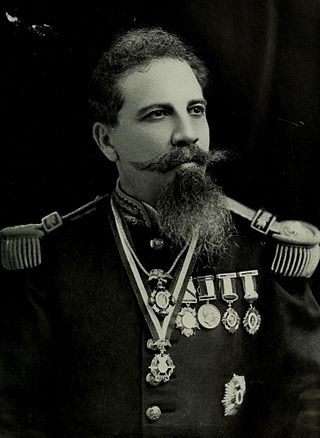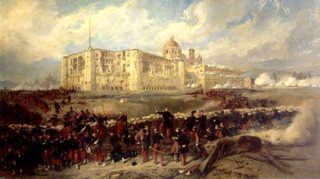
Sebastián Lerdo de Tejada y Corral was a Mexican liberal politician and jurist who served as the 31st president of Mexico from 1872 to 1876.

Bernardo Doroteo Reyes Ogazón was a Mexican general and politician who fought in the Second French intervention in Mexico and served as the appointed Governor of Nuevo León for more than two decades during the Porfiriato. During Reyes's administration as Governor, the state made important economic, industrial and social advances, and he was one of the closest and most faithful allies of President of Mexico Porfirio Díaz. He was killed during a failed coup d'état against President Francisco I. Madero in the first stage of the Mexican Revolution.

The Universidad Autónoma de Guadalajara, commonly abbreviated to UAG or Autónoma, is a coeducational, independent, private university based in the Mexican city of Guadalajara. Established in 1935, it was the first private university and medical school in Mexico. The creation of the university was a conservative response to a more-left wing direction being taken in Mexico in public higher education at the time. It was first conceived with the name Universidad del Occidente, but would later be styled to Universidad Autónoma de Guadalajara (UAG).

The second French intervention in Mexico, also known as the Second Franco-Mexican War (1861–1867), was a military invasion of the Republic of Mexico by the French Empire of Napoleon III, purportedly to force the collection of Mexican debts in conjunction with Great Britain and Spain. Mexican conservatives supported the invasion, since they had been defeated by the liberal government of Benito Juárez in a three-year civil war. Defeated on the battlefield, conservatives sought the aid of France to effect regime change and establish a monarchy in Mexico, a plan that meshed with Napoleon III's plans to re-establish the presence of the French Empire in the Americas. Although the French invasion displaced Juárez's Republican government from the Mexican capital and the monarchy of Archduke Maximilian was established, the Second Mexican Empire collapsed within a few years. Material aid from the United States, whose four-year civil war ended in 1865, invigorated the Republican fight against the regime of Maximilian, and the 1866 decision of Napoleon III to withdraw military support for Maximilian's regime accelerated the monarchy's collapse.

Jean Meyer Barth is a French-Mexican historian and author, known for his writings on early 20th-century Mexican history. He has published extensively on the Mexican Revolution and Cristero War, the history of Nayarit, and on the caudillo Manuel Lozada. He is a faculty member at the Centro de Investigación y Docencia Económicas, and a Guggenheim Fellow.

The Huichol language is an indigenous language of Mexico which belongs to the Uto-Aztecan language family. It is spoken by the ethnic group widely known as the Huichol, whose mountainous territory extends over portions of the Mexican states of Jalisco, San Luis Potosí, Nayarit, Zacatecas, and Durango, mostly in Jalisco. United States: La Habra, California; Houston, Texas. Under the 2003 Law on Indigenous Language Rights, the indigenous languages of Mexico along with Spanish are recognized as "national languages".

The Battle of Calderón Bridge was a decisive battle in the Mexican War of Independence. It was fought in January 1811 on the banks of the Calderón River 60 km (37 mi) east of Guadalajara in present-day Zapotlanejo, Jalisco.
Jesús Guerrero Galván was a Mexican artist, a member of the Mexican muralism movement of the early 20th century. He began his career in Guadalajara but moved to Mexico City to work on mural projects in the 1930s for the Secretaría de Educación Pública and Comisión Federal de Electricidad In addition, he did easel paintings, with major exhibitions in the United States and Mexico. In 1943, he was an artist-in-residence for the University of New Mexico, painting the mural Union of the Americas Joined in Freedom, considered to be one of his major works. Guerrero Galván was accepted as a member of the Salón de la Plástica Mexicana.
Carlos Orozco Romero was a Mexican cartoonist and painter who co-founded several cultural institutions in Mexico, including the Escuela Nacional de Pintura, Escultura y Grabado "La Esmeralda". His work was recognized with membership in the Academia de Artes and the Salón de la Plástica Mexicana, and in 1980, with Mexico's Premio Nacional de Arte.

Manuel Lozada, nicknamed "The Tiger of Álica", was a regional caudillo based in the region of Tepic, Mexico. He was born in 1828 in the Tepic Territory, Mexico and died on July 19, 1873, in Loma de los Metates, Nayarit.

Ricardo Lancaster-Jones y Verea, MA BE KHS was a Mexican historian and scholar who made significant contributions toward the study of the haciendas of the State of Jalisco (Mexico) in the twentieth century. His enthusiasm for history led him to become a professor of Regional History at the Faculty of Philosophy and Letters of Universidad Autónoma de Guadalajara in 1965. Later on, in 1973, he earned his MA degree in Latin American Studies at the University of New Mexico.

Gabriel Flores was a Mexican painter and muralist born in Guadalajara, Jalisco. Between 1956 and 1993, his murals focused on historical and universal themes, as well as the ability of art functioning as social commentary. In the 1960s, at the height of his career, he created his magnum opus Los Niños Héroes, depicting the sacrifice of six child soldiers during the Mexican-American War. Gabriel Flores described himself, saying "I do not want much; I have what I like, above all my freedom."
Gabriel Ruiz Galindo was a Mexican songwriter. He was son of Rosalío Ruiz and Aurelia Galindo. He was a founding member of the Society of Authors and Composers of Mexico. He won the National Award of Arts.

José Corona Núñez was a Mexican author, anthropologist, and history professor who discovered several important archeological sites throughout México. His main body of work revolved around his native state of Michoacán, and in particular the Tarascan or Purépecha culture.

El Tuito is a Mexican agricultural town situated South of the Pacific Ocean's Bahía de Banderas in the Region Costa-Sierra Occidental of the Mexican state of Jalisco. It is the administrative and municipal seat of the municipality of Cabo Corrientes.
Alfonso Toral Moreno was a Mexican short story writer, essayist, and proofreader.

Antonio Rojas, nicknamed El Matacuras, was a Mexican Guerrilla who participated in the Reform War and the Second French intervention in Mexico. He fought independently in both wars due to his differing and controversial strategies and tactics throughout both wars until being killed at Mascota, Jalisco.

Ángel Martínez, also known as the Machetero or El Machete was a Mexican general during the 19th-century. He had a prominent military career during the Second French intervention in Mexico, being a key commander across the state of Colima. He was also a major figure of the Yaqui Wars, notably ordering the execution of Cajemé.
Ramiro Villaseñor y Villaseñor, was a Mexican bibliographer and historian.
Sara Velasco Gutiérrez is a Mexican writer, literary researcher, librarian, and former elementary education and high school teacher.














